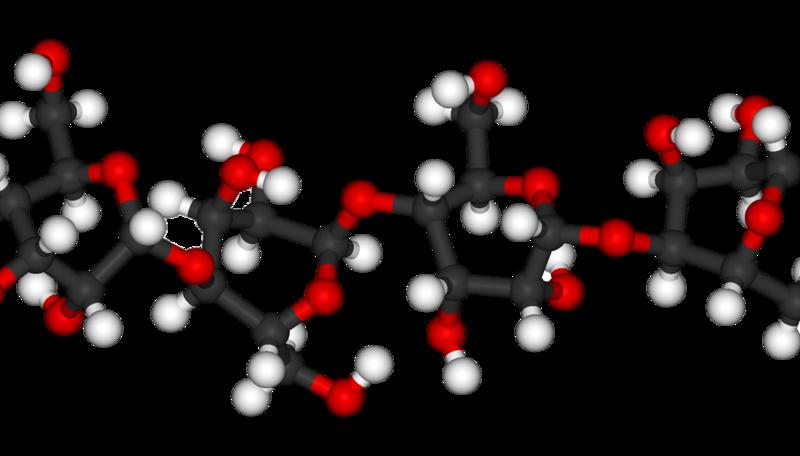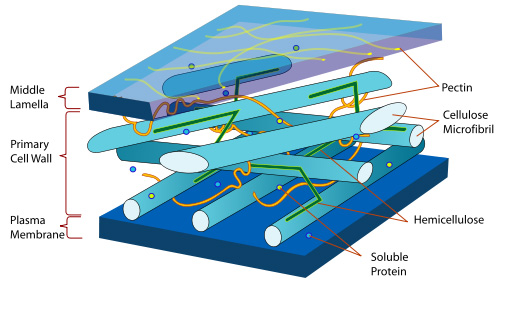Cellulose


Cellulose is an organic compound with the formula (C6H10O5)n. It is a structural polysaccharide derived from beta-glucose.[1][2] Cellulose is the primary structural component of green plants. The primary cell wall of green plants is made of cellulose; acetic acid bacteria are also known to synthesize cellulose, as well as many forms of algae, and the oomycetes. Cellulose was discovered and isolated in the mid-nineteenth century by the French chemist Anselme Payen[3][1] and, as of the year 2006, the estimated annual production of 1.5x109 tonnes.[4] Some animals, particularly ruminants and termites, can digest cellulose with the help of symbiotic micro-organisms (see methanogen). Cellulose is not digestible by humans and is often referred to as 'dietary fiber' or 'roughage', acting as a hydrophilic bulking agent for feces.
Commercial products
Cellulose is the major constituent of paper and textiles made from cotton, linen, and other plant fibers. Cellulose can be converted into cellophane, clear rolling papers made from Viscose film, rayon, and more recently cellulose has been used to make Modal, a bio-based textile derived from beechwood cellulose. Cellulose is used within the laboratory as the stationary phase for thin layer chromatography, and cotton linters, is used in the manufacture of nitrocellulose, historically used in smokeless gunpowder.
Rayon is an important fiber made out of cellulose and has been used for textiles since the beginning of the 20th century.
Cellulose source and energy crops
The major combustible component of non-food energy crops is cellulose, with lignin second. Non-food energy crops are preferred to edible energy crops (which have a large starch component) because they don´t cause inflation of food prices.
Typical non-food energy crops include Switchgrass, Miscanthus, Salix (Willow) and Populus (Poplar) species.
Structure
Cellulose is derived from (β-glucose), which condense through β(1→4)-glycosidic bonds. This linkage motif contrasts with that for α(1→4)-glycosidic bonds present in starch and other carbohydrates. Cellulose is a straight chain polymer: unlike starch, no coiling occurs, and the molecule adopts an extended rod-like conformation. In microfibrils, the multiple hydroxyl groups on the glucose residues hydrogen bond with each other, holding the chains firmly together and contributing to their high tensile strength. This strength is important in cell walls, where they are meshed into a carbohydrate matrix, conferring rigidity to plant cells.
In contrast to starch, cellulose is also much more crystalline. Whereas starch undergoes a crystalline to amorphous transition at 60 -70 °C in water (as in cooking), cellulose requires 320 °C and 25 MPa to become amorphous in water.[5]
Assaying cellulose
Given a cellulose-containing material, the portion that does not dissolve in a 17.5% solution of sodium hydroxide at 20 °C is α cellulose, which is true cellulose. Acidification of the extract precipitates β cellulose. The portion that dissolves in base but does not precipitate with acid is γ cellulose.
Cellulose can be assayed using a method described by Updegraff in 1969, where the fiber is dissolved in acetic and nitric acid, and allowed to react with anthrone in sulfuric acid. The resulting coloured compound is assayed spectrophotometrically at a wavelength of approximately 635 nm.
In addition, cellulose is represented by the difference between acid detergent fiber (ADF) and acid detergent lignin(ADL).
Biosynthesis

In vascular plants cellulose is synthesized at the plasma membrane by rosette terminal complexes (RTC's). The RTC's are hexameric protein structures, approximately 25 nm in diameter that contain the cellulose synthase enzymes that synthesise the individual cellulose chains.[6] The RTC's contain at least three different cellulose synthases, encoded by CesA genes, in an unknown stoichiometry.[7] Separate sets of CesA genes are involved in primary and secondary cell wall biosynthesis. Cellulose synthase utilizes UDP-D-glucose precursors to generate microcrystalline cellulose. Cellulose synthesis requires chain initiation and elongation, and the two processes are separate. CesA glucosyltransferase initiates cellulose polymerization using a steroid primer, 'sitosterol-beta-glucoside' and UDP-glucose.[8] A cellulase may function to cleave the primer from the mature chain.
Breakdown (cellulolysis)
Cellulolysis is the process relating to or causing the hydrolysis of cellulose (i.e. cellulolytic bacteria, fungi or enzymes).
Mammals do not have the ability to break down cellulose directly. Typically, this ability is possessed only by certain bacteria (which have specific enzymes) like Cellulomonas etc., and which are often the flora on the gut walls of ruminants like cows and sheep, or by fungi, which in nature are responsible for cycling of nutrients. The enzymes utilized to cleave the glycosidic linkage in cellulose are glycoside hydrolases including endo-acting cellulases and exo-acting glucosidases. Such enzymes are usually secreted as part of multienzyme complexes that may include dockerins and cellulose binding modules, referred to in some cases as cellulosomes.
Many cellulolytic bacteria, fungi or enzymes break down cellulose into shorter linked chains known as cellodextrins.
Derivatives
The hydroxyl groups of cellulose can be partially or fully reacted with various reagents to afford derivatives with useful properties. Cellulose esters and cellulose ethers are the most important commercial materials. In principle, though not always in current industrial practice, cellulosic polymers are renewable resources.
Among the esters are cellulose acetate and cellulose triacetate, which are film- and fiber-forming materials that find a variety of uses. The inorganic ester nitrocellulose was initially used as an explosive and was an early film forming material.
Ether derivatives include
- Ethylcellulose, a water-insoluble commercial thermoplastic used in coatings, inks, binders, and controlled-release drug tablets;
- Methylcellulose;
- Hydroxypropyl cellulose;
- Carboxymethyl cellulose;
- Hydroxypropyl methyl cellulose, E464, used as a viscosity modifier, gelling agent, foaming agent and binding agent;
- Hydroxyethyl methyl cellulose, used in production of cellulose films.
References
- ↑ 1.0 1.1 Crawford, R. L. (1981). Lignin biodegradation and transformation. New York: John Wiley and Sons. ISBN 0-471-05743-6.
- ↑ Updegraff DM (1969). "Semimicro determination of cellulose in biological materials". Analytical Biochemistry. 32: 420–424.
- ↑ Young, Raymond (1986). Cellulose structure modification and hydrolysis. New York: Wiley. ISBN 0471827614.
- ↑ Discovery of Cellulose as a Smart Material Jaehwan Kim* and Sungryul Yun Macromolecules, 2006, 4202 -4206, doi:10.1021/ma060261e
- ↑ Cooking cellulose in hot and compressed water Shigeru Deguchi, Kaoru Tsujii and Koki Horikoshi Chem. Commun., 2006, 3293 - 3295, doi:10.1039/b605812d
- ↑ Kimura, Laosinchai, Itoh, Cui, Linder, Brown, Plant Cell, 1999, 11, 2075-2085
- ↑ Taylor, Howells, Huttly, Vickers, Turner, PNAS, 2003, 100, 1450-1455
- ↑ Peng, Kawagoe, Hogan, Delmer, Science, 2002, 295, 147-150.
See also
External links
- LSBU cellulose page
- Clear description of a cellulose assay method at the Cotton Fiber Biosciences unit of the USDA.
- Cellulose films could provide flapping wings and cheap artificial muscles for robots - TechnologyReview.com
- Using cellulase enzymes in the bioethanol process.
- The use of Cellulose in disposable diapers
- A list of cellulolytic bacteria.
- Manufacturers of fluff cellulose all over the world
ar:سليولوز bs:Celuloza bg:Целулоза ca:Cel·lulosa cs:Celulosa da:Cellulose de:Cellulose et:Tselluloos eo:Celulozo hr:Celuloza io:Celulozo id:Selulosa is:Sellulósi it:Cellulosa he:תאית lt:Celiuliozė hu:Cellulóz mk:Целулоза nl:Cellulose no:Cellulose nn:Cellulose oc:Cellulòsa sq:Celuloza simple:Cellulose sr:Целулоза su:Selulosa fi:Selluloosa sv:Cellulosa th:เซลลูโลส uk:Целюлоза